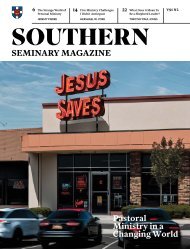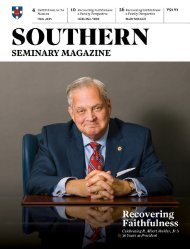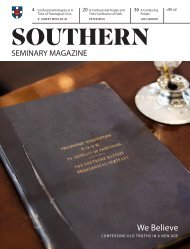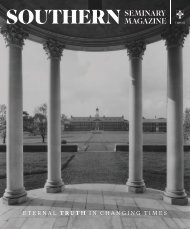Southern Seminary Magazine (Vol 90.1) The Light of Truth: Apologetics in the 21st Century
Create successful ePaper yourself
Turn your PDF publications into a flip-book with our unique Google optimized e-Paper software.
kyle d. claunch<br />
<strong>in</strong> Genesis 1-11 that marks it as an entirely different genre<br />
than <strong>the</strong> rest <strong>of</strong> <strong>the</strong> book or o<strong>the</strong>r examples <strong>of</strong> historical<br />
narrative <strong>in</strong> <strong>the</strong> Bible. Fur<strong>the</strong>rmore, as noted earlier, <strong>the</strong><br />
historical genealogies <strong>of</strong> Scripture, such as <strong>the</strong> extensive<br />
one <strong>in</strong> 1 Chronicles and <strong>the</strong> genealogy <strong>of</strong> Jesus <strong>in</strong> Luke<br />
3 give no <strong>in</strong>dication <strong>of</strong> a different mode <strong>of</strong> historical account<br />
with respect to <strong>the</strong> names on <strong>the</strong> list prior to Abraham.<br />
As important as <strong>the</strong> affirmation <strong>of</strong> <strong>the</strong> historicity <strong>of</strong><br />
Adam is for Christian <strong>the</strong>ology, ground<strong>in</strong>g one’s <strong>the</strong>ology<br />
<strong>in</strong> <strong>the</strong> text <strong>of</strong> Scripture by means <strong>of</strong> a consistent hermeneutic<br />
is equally important, and it is precisely here that <strong>the</strong><br />
mytho-history approach <strong>of</strong> Craig and o<strong>the</strong>rs fails.<br />
2<br />
Genesis 1 as Non-Historical Literature. O<strong>the</strong>r<br />
<strong>in</strong>terpreters affirm that <strong>the</strong> genre <strong>of</strong> <strong>the</strong> account<br />
from Adam to Abraham is not markedly different<br />
than <strong>the</strong> account from Abraham forward, but <strong>the</strong>y<br />
do see a difference <strong>in</strong> genre between Genesis 1 and Genesis<br />
2 and follow<strong>in</strong>g. In o<strong>the</strong>r words, <strong>the</strong> historical narrative<br />
genre beg<strong>in</strong>s with Genesis 2:4 and is <strong>in</strong>dicated us<strong>in</strong>g <strong>the</strong><br />
Hebrew word tôlǝdôt (“<strong>the</strong>se are <strong>the</strong> generations <strong>of</strong> ”). This<br />
expression is a key literary feature mark<strong>in</strong>g <strong>the</strong> historical<br />
cont<strong>in</strong>uity <strong>of</strong> <strong>the</strong> Genesis narrative, l<strong>in</strong>k<strong>in</strong>g <strong>the</strong> descendants<br />
<strong>of</strong> Abraham with <strong>the</strong> rest <strong>of</strong> mank<strong>in</strong>d.<br />
Prior to <strong>the</strong> tôlǝdôt <strong>of</strong> Genesis 2:4, <strong>the</strong> text is seen as<br />
communicat<strong>in</strong>g <strong>in</strong> some way o<strong>the</strong>r than straightforward<br />
historical narrative. On this view, <strong>the</strong> six-day creation account<br />
<strong>of</strong> Genesis 1 is not historical narrative, but a literary<br />
unit <strong>in</strong>tended to convey <strong>the</strong>ological truth about God, man,<br />
creation, and God’s redeem<strong>in</strong>g purposes. Thus, <strong>the</strong> weeklong<br />
structure <strong>of</strong> particular creative events occurr<strong>in</strong>g on<br />
sequential days is an extended metaphor ra<strong>the</strong>r than a<br />
literal week <strong>of</strong> history. <strong>The</strong>re are multiple versions <strong>of</strong> this<br />
view, sometimes called <strong>the</strong> literary framework <strong>the</strong>ory. <strong>The</strong><br />
strength <strong>of</strong> <strong>the</strong> view with respect to <strong>the</strong> question <strong>of</strong> <strong>the</strong><br />
historical Adam is its space for one to ma<strong>in</strong>ta<strong>in</strong> a commitment<br />
to <strong>the</strong> historicity <strong>of</strong> <strong>the</strong> life <strong>of</strong> Adam and Eve and <strong>the</strong><br />
o<strong>the</strong>r events <strong>of</strong> Genesis 2–11 about which <strong>the</strong> New Testament<br />
speaks as historical.<br />
However, <strong>the</strong> sharp divide between <strong>the</strong> historicity <strong>of</strong><br />
Genesis 2 and <strong>the</strong> non-historical character <strong>of</strong> Genesis 1 is<br />
not without problems. Perhaps <strong>the</strong> greatest difficulty is <strong>the</strong><br />
fact that Jesus identifies <strong>the</strong> man and <strong>the</strong> woman who are<br />
jo<strong>in</strong>ed toge<strong>the</strong>r <strong>in</strong> Genesis 2:24 as <strong>the</strong> “male and female”<br />
created on day six <strong>in</strong> Genesis 1. In Mat<strong>the</strong>w 19:1–10, when<br />
asked about <strong>the</strong> legitimacy <strong>of</strong> divorce, Jesus cites Genesis<br />
1:27, which says that God made <strong>the</strong>m male and female “<strong>in</strong><br />
<strong>the</strong> beg<strong>in</strong>n<strong>in</strong>g.” He <strong>the</strong>n moves seamlessly <strong>in</strong>to a quotation<br />
<strong>of</strong> Genesis 2:24, not<strong>in</strong>g that God jo<strong>in</strong>ed <strong>the</strong> two toge<strong>the</strong>r.<br />
In o<strong>the</strong>r words, Jesus unhesitat<strong>in</strong>gly identifies <strong>the</strong> “male<br />
and female” <strong>of</strong> chapter 1 with <strong>the</strong> “man and woman” who<br />
were united as one flesh <strong>in</strong> chapter 2.<br />
This k<strong>in</strong>d <strong>of</strong> identity seems to <strong>in</strong>dicate that Jesus understood<br />
<strong>the</strong> detailed account <strong>of</strong> <strong>the</strong> creation <strong>of</strong> man and<br />
woman and <strong>the</strong>ir union <strong>in</strong> marriage as giv<strong>in</strong>g greater<br />
detail to <strong>the</strong> general creation narrative <strong>of</strong> <strong>the</strong> back half<br />
<strong>of</strong> <strong>the</strong> sixth day <strong>in</strong> Genesis 1. <strong>The</strong> upshot <strong>of</strong> all <strong>of</strong> this is<br />
that Jesus assumes <strong>the</strong> historical character <strong>of</strong> both Genesis<br />
1 and Genesis 2.<br />
3<br />
<strong>The</strong> Days <strong>of</strong> Creation as Long Days. Ano<strong>the</strong>r view<br />
sees <strong>the</strong> entirety <strong>of</strong> <strong>the</strong> open<strong>in</strong>g chapters <strong>of</strong> Genesis<br />
as historical. However, <strong>the</strong> six “days” <strong>of</strong> creation<br />
are not 24-hour days but ra<strong>the</strong>r very long epochs<br />
<strong>of</strong> time. A “day” <strong>of</strong> creation may cover a time-period <strong>of</strong><br />
hundreds <strong>of</strong> thousands to many millions <strong>of</strong> years. On this<br />
summer 2022<br />
15






